
Amphibians are ectothermic, anamniotic, four-limbed vertebrate animals that constitute the class Amphibia. In its broadest sense, it is a paraphyletic group encompassing all tetrapods, excluding the amniotes. All extant (living) amphibians belong to the monophyletic subclass Lissamphibia, with three living orders: Anura (frogs), Urodela (salamanders), and Gymnophiona (caecilians). Evolved to be mostly semiaquatic, amphibians have adapted to inhabit a wide variety of habitats, with most species living in freshwater, wetland or terrestrial ecosystems. Their life cycle typically starts out as aquatic larvae with gills known as tadpoles, but some species have developed behavioural adaptations to bypass this.

The hellbender, also known as the hellbender salamander, is a species of aquatic giant salamander endemic to the eastern and central United States. It is the largest salamander in North America. A member of the family Cryptobranchidae, the hellbender is the only extant member of the genus Cryptobranchus. Other closely related salamanders in the same family are in the genus Andrias, which contains the Japanese and Chinese giant salamanders. The hellbender, which is much larger than all other salamanders in its geographic range, employs an unusual means of respiration, and fills a particular niche—both as a predator and prey—in its ecosystem, which either it or its ancestors have occupied for around 65 million years. The species is listed as Vulnerable on the IUCN Red List of Threatened Species due to the impacts of disease and widespread habitat loss and degradation throughout much of its range.

Salamanders are a group of amphibians typically characterized by their lizard-like appearance, with slender bodies, blunt snouts, short limbs projecting at right angles to the body, and the presence of a tail in both larvae and adults. All ten extant salamander families are grouped together under the order Urodela from the group Caudata. Salamander diversity is highest in eastern North America, especially in the Appalachian Mountains; most species are found in the Holarctic realm, with some species present in the Neotropical realm.
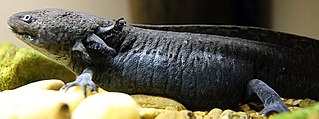
The axolotl is a paedomorphic salamander closely related to the tiger salamander. It is unusual among amphibians in that it reaches adulthood without undergoing metamorphosis. Instead of taking to the land, adults remain aquatic and gilled. The species was originally found in several lakes underlying what is now Mexico City, such as Lake Xochimilco and Lake Chalco. These lakes were drained by Spanish settlers after the conquest of the Aztec Empire, leading to the destruction of much of the axolotl's natural habitat.

The mole salamanders are a group of advanced salamanders endemic to North America. The group has become famous due to the presence of the axolotl, widely used in research due to its paedomorphosis, and the tiger salamander which is the official amphibian of many US states, and often sold as a pet.

The Cryptobranchidae are a family of fully aquatic salamanders commonly known as the giant salamanders. They include some of the largest living amphibians. The family is native to China, Japan, and the eastern United States. They constitute one of two living families—the other being the Asiatic salamanders belonging to the family Hynobiidae—within the Cryptobranchoidea, one of two main divisions of living salamanders.

Plethodontidae, or lungless salamanders, are a family of salamanders. With over 500 species, lungless salamanders are by far the largest family of salamanders in terms of their diversity. Most species are native to the Western Hemisphere, from British Columbia to Brazil. Only two extant genera occur in the Eastern Hemisphere: Speleomantes and Karsenia.

Ambystomatidae is a family of salamanders belonging to the Suborder Salamandroidea in the class Amphibia. It contains two genera, Ambystoma and Dicamptodon. Ambystoma contains 32 species and are distributed widely across North America, while Dicamptodon contains four species restricted to the Pacific Northwest. These salamanders are mostly terrestrial and eat invertebrates, although some species are known to eat smaller salamanders. They can be found throughout the US and some areas of Canada in damp forests or plains. This family contains some of the largest terrestrial salamanders in the world, the tiger salamander and the coastal giant salamander. Some species are toxic and can secrete poison from their bodies as protection against predators or infraspecific competition. Neoteny has been observed in several species in Ambystomatidae, and some of them like the axolotl live all of their lives under water in their larval stage.
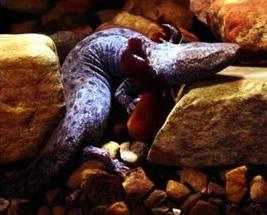
The family Proteidae is a group of aquatic salamanders found today in the Balkan Peninsula and North America. The range of the genus Necturus runs from southern central Canada, through the midwestern United States, east to North Carolina and south to Georgia and Mississippi. The range of the olm, the only extant member of the genus Proteus, is limited to the Western Balkans. The fossil record of the family extends into the end of the Late Cretaceous, with Paranecturus being known from the Maastrichtian of North America.

The two-toed amphiuma is an aquatic salamander widely distributed in the southeastern United States. It is commonly, but incorrectly, called "congo snake", "conger eel" or the "blind eel".

Taylor's salamander is a species of salamander found only in Laguna Alchichica, a high-altitude crater lake to the southwest of Perote, Mexico. It was first described in 1982 but had been known to science prior to that. It is a neotenic salamander, breeding while still in the larval state and not undergoing metamorphosis. The lake in which it lives is becoming increasingly saline and less suitable for the salamander, which is declining in numbers. The International Union for Conservation of Nature (IUCN) has rated it as being "critically endangered".

Anderson's salamander is a neotenic salamander from Zacapu Lagoon in the Mexican state of Michoacán.

The Lake Patzcuaro salamander, locally known as achoque, is a paedomorphic species of salamander found exclusively in Lake Pátzcuaro, a high-altitude lake in the Mexican state of Michoacán. First described in 1870 by Alfredo Dugès, the species is named in honor of the French herpetologist Auguste Duméril. However, the salamander has been used as a food source and an ingredient in traditional medicines by the Purépecha people since the Pre-Columbian era. Ambystoma dumerilii are neotenic, meaning they retain their larval characteristics throughout their entire life. This results in adults that have long, heavily filamented external gills, gill slits lined with tooth-like gill rakers, and caudal fins. When stressed, Ambystoma dumerilii can undergo an incomplete metamorphosis, though this is process significantly decreases their lifespan and is often fatal.

The blunt-headed salamander is a mole salamander endemic to Mexico. It is only known from the vicinity of its type locality, near Morelia, in Michoacán state in Southwestern Mexico. It inhabits a landscape consisting of a mosaic of natural grasslands and pine-oak forests at elevations of about 2,000 m (6,600 ft) asl. Breeding takes place in ponds. An average adult has a mass of 6.18 grams while wet. Adult females of the species range from 42-93 mm and males range from 45.4-70.5 mm in standard length.

Siren is a genus of aquatic salamanders of the family Sirenidae. The genus consists of five living species, along with one extinct species from the Eocene Epoch and three from the Miocene.

The lesser siren is a species of aquatic salamander native to the eastern United States and northern Mexico. They are referred to by numerous common names, including two-legged eel, dwarf siren, and mud eel. The specific epithet intermedia denotes their intermediate size, between the greater siren, Siren lacertina, and the dwarf sirens, Pseudobranchus species.
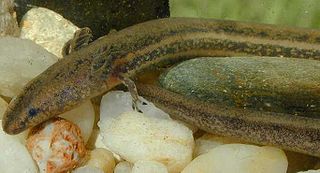
The northern dwarf siren is a perennibranch salamander lacking hind legs. Found in the Southeastern United States, it one of two currently recognized species of dwarf sirens. Three subspecies are currently recognized; P. s. striatus, the broad-striped dwarf siren, P. s. lustricolus, the Gulf Hammock dwarf siren, and P. s. spheniscus, the slender dwarf siren.
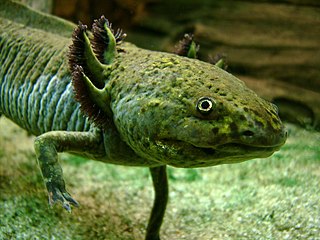
External gills are the gills of an animal, most typically an amphibian, that are exposed to the environment, rather than set inside the pharynx and covered by gill slits, as they are in most fishes. Instead, the respiratory organs are set on a frill of stalks protruding from the sides of an animal's head.

The ocoee salamander is a species of salamander in the family Plethodontidae. This salamander has a variety of colors and patterns, and got its name from Tennessee state wildflower. Its natural habitats are temperate forests, rivers, intermittent rivers, freshwater springs and wet rocks in mountainous areas of the Southeastern United States. It was first described by Nicholls in 1949. They are territorial and feed on small invertebrates. It is widely distributed in the southeastern United States and is listed as "Least Concern" by the International Union for Conservation of Nature.
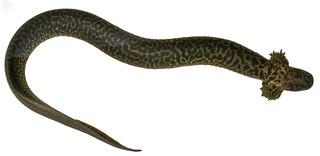
The reticulated siren, also known as the leopard siren or colloquially as the leopard eel, is a species of aquatic salamander in the family Sirenidae. The species, which is endemic to the southeastern United States, was first formally described in 2018. This cryptic salamander is known only from three localities in southern Alabama and the Florida panhandle and is one of the largest animals in the United States to be newly described in the past 100 years.



















